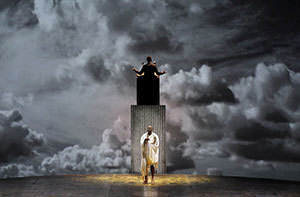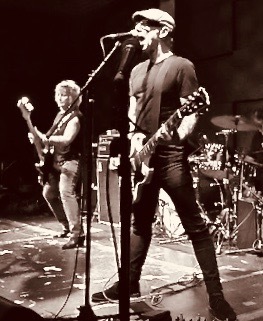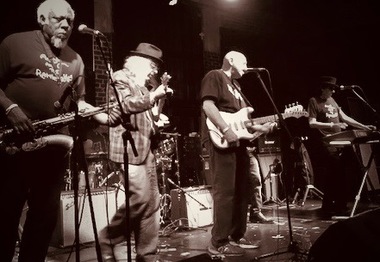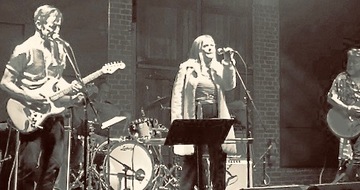Life is just an excuse for music. I learned that Sunday with "Satyagraha" and Radio Free Hollywood 2.

"Satyagraha," the title of the Phillip Glass opera at the Dorothy Chandler Pavilion, means truth force -- a timely notion. My Sanskrit's rusty, but I suspect the production was about Gandhi. That mattered mainly because Gandhi inspired Glass to write music and Phelim McDermott & Julian Crouch to create images. Since Glass knows that his endless arpeggios madden audiences or put them to sleep, he sequenced these cycles in ever-changing segments of 3 to 12 beats per measure, performed by an orchestra, a big chorus and a crappy old synthesizer. So the variations kept us mostly calm and awake enough to experience three hours of wondrous non-digital visuals: a giant god battling a giant goddess, a giant segmented crocodile winding across the stage, giant humans/monsters/skeletons looming from behind 2D buildings, many newsprint pages reconfiguring into vital abstractions, richly garbed singers moving ever so deliberately, parallel skeins of plastic wrap converging into a spidery 30-foot man who died and collapsed into a white skybound soul. Inspired. Brahma transformed into Martin Luther King Jr. as Gandhi decayed into peace, and somehow we leaked eye moisture, smitten by our own lack of the devotion the Bhagavad Gita demands. So maybe the story did mean something.
Then we went out for refueling, and Joachim Splichal had us arrested for aggravated privilege.

I did not make bail in time to reach the Bootleg Theater in time for the beginning of Radio Free Hollywood 2, a celebration and partial reunion of the independent rock music scene sparked by a 1976 Troupers Hall gig featuring the Dogs (above), the Motels and the Pop. So I missed the Last, who played first as Jesus predicted, and that grieved me, so I continued to hum "She Don't Know Why I'm Here" for days anyway. Missed the Furys and Fur Dixon too. But I did get to absorb short sets by a lot of old bands, many of which featured women, a bit of a revolution in the '70s.
The Model popped and rocked hard, with a small woman honking a big baritone sax. They did a hooky song I recognized; probably Rodney used to spin it.
The Flames had a churnier thing, kinda pre-punk.
Gregg Sutton, oversize beret slopping over face, leaned toward the Springsteenian side, with Paul Lacques augmenting the lineup on stinging lead guitar.
Backstage Pass, all femme except Chris Bailey on drums, rollicked their all-femme locomotive; Kristi Callan of Wednesday Week sang in solidarity.
The Hollywood Stars slammed at least as professionally as when Kim Fowley repped them in '74, stealing from Slade and anthemizing proficiently on "All the Kids in the Street" and "King of the Nighttime World."
The Textones -- whip-blonde Carla Olson and friends -- slammed the rootsy pop with full confidence bordering on f*ck-y'all. Sax, even. A highlight.
The Pop had not corralled David Swanson or Roger Prescott, so Nicky Corbett stepped up with their rhythm section to wail "Down on the Boulevard" and her own straight-ahead struttifications.

Andy & the Rattlesnakes stepped up with the night's bluesiest feel thanx to the sax of Jeff Hollie, the tanklin' piano of Morley Bartnof and the searing guitar of Paul Lacques (his second service of the night despite the flu); Andy Krikun testified with the ruff soul and good humor that come with his no-quit attitude.
Code Blue showed why they were the scene's head-snappinest and most original band, with ex-Motel Dean Chamberlain chopping his guitar with mean determination. Uh!
The Dogs, goddamn. Hair updated and ferocity intact, Michiganders Loren Molinare and Mary Kay rocked just as tight as when they used to share bills with Van Halen. Loren even struck the classic guitar-hero wide-straddle pose with full fllexibility.

Warfield Foxes had Chamberlain and Chuck Wada cranking pre-recognition Motels classics like "What Ever Happened to the Modern Lovers," Nicky Corbett returning to wrangle the Martha Davis parts and swinging the de rigueur light stick. That high-energy early version of the band was something special; great to hear an alternate shot at it.
Everybody looked as good as you could expect, sometimes better. Gratitude went to radio host Rodney Bingenheimer (not present), who exposed many of these bands when no one else would; I spotted him a few months ago in a drugstore parking lot, still sporting spiked hair, getting into his vintage muscle car with the LIL GTO license plate. Music is the best medicine.
We all reflected on the many musicians who have not survived, our memories strong and often wrong. After all, RFH happened long enough ago to replace every cell in our bodies . . . six times.
SEPIA BAND PHOTOS BY FUZZY BOG.
